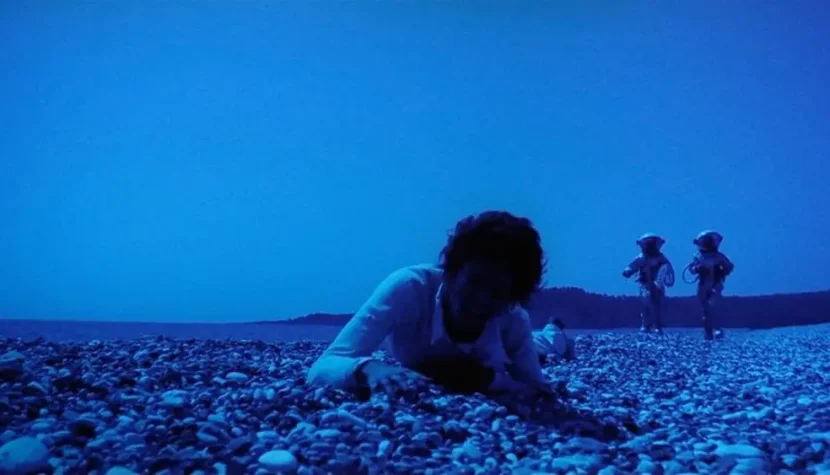FOOTPRINTS ON THE MOON. Thriller in the good old style

There’s something of Roman Polanski’s “Repulsion” (1965) and “The Tenant” (1976) here, as well as José Ramón Larraz’s “Symptoms” (1974), but in “Footprints on the Moon” Bazzoni mostly speaks his own language.
After watching the film “Footprints on the Moon”, young translator Alice is haunted by a recurring dream in which an astronaut is abandoned on the surface of the moon by a sinister mission commander. To cope with the trauma, she takes tranquilizers. One day, Alice is fired from her job for an unexcused absence that she cannot explain, as she remembers nothing from the past three days. When she finds a postcard in her apartment depicting a hotel in Garma, a place she’s never been, and a bloodstained yellow dress she’s never seen before, she decides to visit the Turkish island shown on the postcard. Alice’s confusion only deepens when the residents of Garma inform her that she had been there a few days earlier, but with a different hairstyle and using a different name. Alice is helped in unraveling the mystery by two locals: a young man named Henry and a mysterious little girl named Paula.

Unlike many other Italian directors of his generation, such as Joe D’Amato or Antonio Margheriti, Luigi Bazzoni faced significant challenges in developing his film career. Perhaps this was because he wasn’t the type to grab any opportunity to direct just any movie. Bazzoni believed that it was only worth working when there was an intangible connection between the creator and the material—and for this reason, he directed only five feature films: two giallo films [“The Possessed” (1965) and “The Fifth Cord” (1971)], two westerns [“Man, Pride and Vengeance” (1967) and “Blu Gang – And They Lived Happily Ever After” (1973)], and one thriller, which was also his last feature film, “Footprints on the Moon” (1975). Bazzoni’s filmography, before his death in 2012, was capped off by a six-part documentary series, “Roma Imago Urbis” (1994–1995).
“Footprints on the Moon” is an adaptation of “Las Huellas”, a novel by Mario Fanelli, an Italian-Argentinian screenwriter and writer who co-wrote the scripts for three of Bazzoni’s films (“Footprints”, “The Fifth Cord”, and “Blu Gang – And They Lived Happily Ever After”). Filming began in the spring of 1974, with locations in Italy and Turkey. Florinda Bolkan, a Brazilian model and actress known for her roles in films by Luchino Visconti, Elio Petri, Vittorio De Sica, Enrico Maria Salerno, and Lucio Fulci, was cast as Alice. Bolkan admitted years later that her role in “Footprints” took a toll on her psyche and body: she lost five kilograms during filming, and after production wrapped, she had difficulty “parting” with the character of Alice. The supporting cast included Peter McEnery (Henry), Nicoletta Elmi (Paula), and Klaus Kinski (Blackmann), who made yet another of his many brief but memorable appearances.

Bazzoni’s forgotten film is a thriller in the good old style. The mystery of Alice’s amnesia becomes the viewer’s mystery as well, as the director masterfully pulls the audience into the world he presents, building tension with precise craftsmanship—without resorting to jump scares, gallons of blood, deranged killers, or heaps of bodies (in fact, only one character dies!). Together with Alice, we discover each new piece of the puzzle, with the disturbing atmosphere contrasting the picturesque surroundings beautifully shot by Vittorio Storaro [the cinematographer behind “Apocalypse Now” (1979) by F.F. Coppola and “The Last Emperor” (1987) by Bernardo Bertolucci]. Bazzoni doesn’t exhaust the audience with endless ambiguities: while he leads us through twists and multiple interpretations, he ultimately explains everything in a poignant, tragic finale. One of the most intriguing Italian films of the 1970s.

